
This Year's Wheat Harvest and New Harvesting Methods
Hello friends,
We grew wheat again in the 2023/2024 season with the hope to grow enough flour to make a loaf of homemade bread. We planted out our wheat seeds back in November 2023, and had a great harvest in February 2024 this year. If you want to learn more about growing wheat at home you can read it in this blog post.
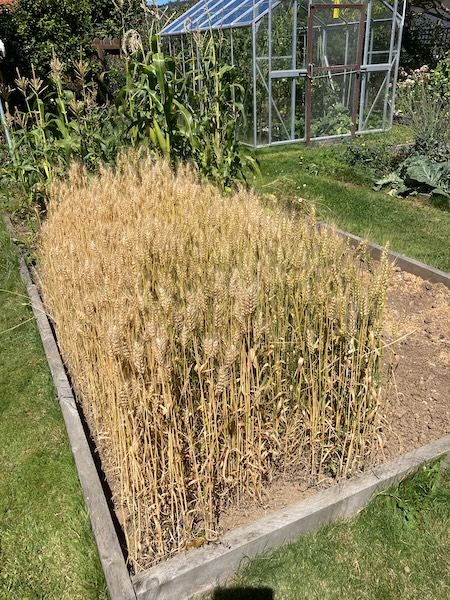
With the wheat harvested, I dried it in readiness for processing. This year I wanted to try some new processing methods, to see if they would be more efficient than last year's methods. The first new method was to try removing the wheat heads from the stalks using a garden chipper/shredder. You can see footage on Youtube of this happening here.
Luckily we had a garden shredder in our garage, so we got to work. It didn't take very long at all to harvest the wheat heads from the stalks. The wheat heads fell into the hopper below, and the stalks were dug back into the garden bed from where they came from. I had hoped that the garden chipper would break open the wheat heads, but unfortunately they were still mostly intact afterward.

The next step was to thresh the wheat. Last year we just bashed the wheat heads with a piece of wood, but it was a lot of work. But I found this video on YouTube recently of someone threshing wheat with a flail.
Eager to try this method out, I bought two broom handles from Mitre 10 (broom handles are much cheaper than dowel), two metal eyes, and a length of rope. Once I got home I sawed off the ends of the two broom handles so that one handle was 1.5 m long, and the other 1 m long. I then tied them together with a length of rope.
Hubby got to work threshing the wheat heads on an old sheet. It turns out that the 1 m length of flail that was hitting the wheat heads was too long, so we cut it down to 75 cm. Another problem was that the wheat heads were flying off in every direction when hit, so we wrapped the wheat heads up into the sheet like a burrito, to keep them all in one place. After a couple of minutes of threshing using this method, it was completed. We separated the bigger pieces of plant material by hand, and then used a large sieve to further remove the medium-sized pieces of plant material.
When we thresh the wheat again next year I think we will alter the flail, and use leather strips to connect the two broom handles. The rope had a tendency to come undone, and the short piece of broom handle doing the threshing would fly off. I would also love to invest in a seed saving screen from Crafty Gatherer NZ, but it's pretty pricey.
After that, all that remained was the wheat berries and the chaff. The next step was winnowing. After watching the videos above, we saw that most people used small fans to separate the wheat from the chaff. Luckily it was now autumn, and most places were selling off fans very cheaply. Hubby took a trip to our local Mitre 10, and purchased a fan at a decent price.
He set up the fan, and got to work winnowing. The videos above suggested working a slow speed for the first pass, to remove dust, and then work your way up to faster speeds to get rid of bigger material. With the help of the fan we got the winnowing done a period of less than five minutes. With a constant breeze, it made the job so much easier.
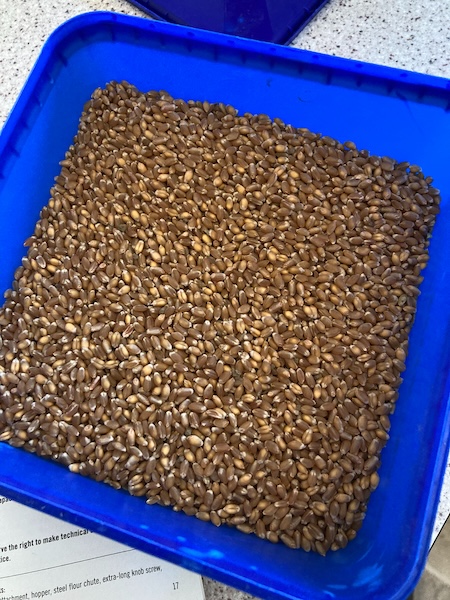
With the winnowing done, the processing of the wheat was complete. Overall, these new wheat processing methods saved us a lot of time, and it also made the process so much easier. We'll be using this method again next year when we grow our own wheat. In a future blog I will be showing the wheat milling process, and also our recipe for making bread in a bread maker.
Have a wonderful day
Julie-Ann
Want to discuss my post? Feel free to chat with me on Instagram or Mastodon or Bluesky.
Processing Our Own Homegrown Wheat
Hello friends,
In an earlier blog post I shared with you how I grew wheat from seed last summer. In this blog post I share with you how I processed the wheat seeds, and turned it into flour.
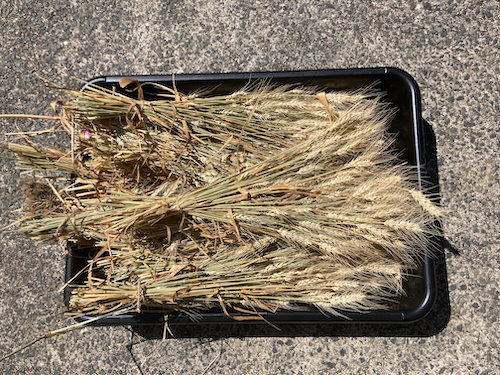
The first step in processing the dried wheat is threshing, whereby you loosen the wheat seeds from the attached straw and wheat head. After looking at a lot of videos on YouTube, we found two methods that would be relatively easy for a home grower to try.
The first method was pretty simple, basically it involved taking bunches of wheat and slapping it between the two sides of a bucket back and forth in a fast and furious manner. It sure made for a good arm workout.
The second method involved bashing the wheat head with a big stick, while not losing any of the wheat seeds in the process. We decided the easiest way for us to do this was to put the bunches of wheat into a fine pillow case, and bashing it with a flat piece of wood.
After experimenting to see how much the wheat seeds would loosen after using each threshing method, we decided that the best way forward would be to use both methods. I did the bucket method, and then passed what was left over to hubby for him to bash with a piece of wood.
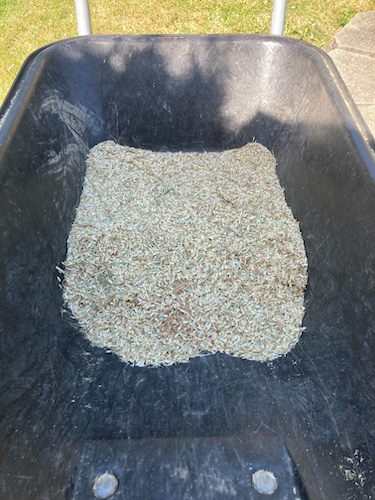
What you end up with is a mix of wheat seeds and chaff. WIth threshing done, it was onto the winnowing process to remove the wheat seeds from the chaff. After watching even more videos on YouTube, I decided that the easiest way to winnow the wheat was to wait for a super windy day, and then get the wind to blow the chaff away from the wheat as I dropped the mixture into a wheel barrow. I used a wheel barrow for this process because it gave me a big area to winnow in, and the high sides of the wheel barrow meant that seeds were less likely to blow away.
The trick I soon learnt was that there is a specific height you hand has to be at to remove the chaff without losing the wheat seeds over the edge in the process, and this was mainly dependent on how hard the wind is blowing. If the wind is very strong, it's best to keep your hand close to the wheel barrow, and if the wind was light you could raise your hand higher. Also another thing to note, is that the wheat chaff is very dry and sharp and pointy, and it hurts your fingers, so wearing gloves is a must. The winnowing step was the most time intensive step, and I had to repeat the winnowing multiple times to get rid of most of the chaff from the wheat seeds.
WIth the main winnowing step complete, we then by hand had to pick out any stray bits of chaff from the wheat, along with any other random bits of stuff that had made it through the previous steps, and this also took a while, but it was made easier by watching TV while we did so.
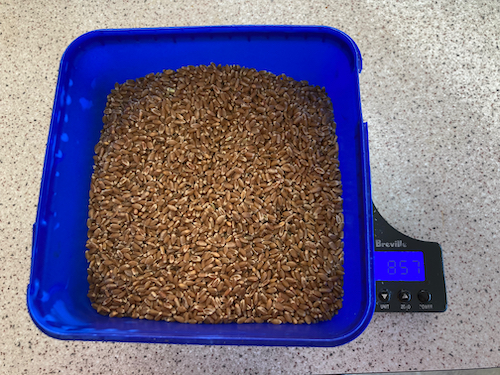
Finally after all those steps, all we had left was wheat seeds, and in particular 857 grams of homegrown wheat seeds. Getting to this stage was quite a feat in itself, but we hadn't even gotten to the milling stage yet. So it was back to the internet and in particular YouTube to see how we could mill the wheat into a fine enough grade for making bread...
The following methods suggested to mill the grain into flour did not work for us:
1 - Using a mortar and pestle - Didn't do anything at all, a complete waste of time.
2 - Using our coffee and spice grinder - It did chop the grains into a couple of pieces each, but did not mill it at all
3 - Using our food processor - Didn't do much better than the coffee and spice grinder.
This was all pretty frustrating, but the good thing about wheat seeds is that they can store for over a year as is in a sealed container at room temperature (much longer than flour can), so we left it while we pondered what we could do. Hubby and I finally came to the conclusion that the only way forward would be to buy a mill of our own. There are a lot of options in New Zealand to buy stand alone home mills, but most were super expensive, and were much bigger and stronger than what we needed.
But then, while perusing the Flour Power Mills website, we found a small stone mill that would attach to our KitchenAId stand mixer. The Mockmill Stone Mill attachment was at least half the price of the smallest stand alone mills available, and as a bonus it would also mill a wide range of other grains and legumes (including amanath, chia seeds, oats, millet, chickpeas, maize, barley, dried rice, quinoa, rye, and dried soya beans), as well as milling a whole bunch of herb and spice seeds...
It wasn't too long before the Mockmill Stone Mill had arrived by courier, and hubby attached it to our KitchenAid stand mixer.
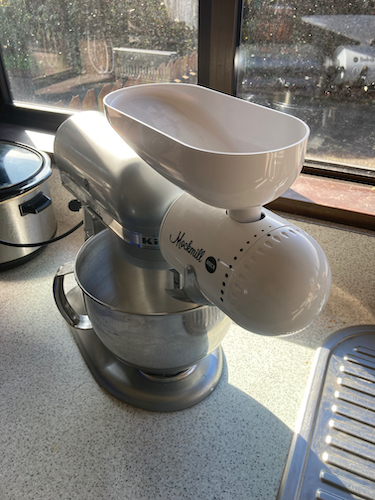
The set up was pretty easy, and all we had to do was set the mill to a fine setting, and then put the wheat seeds in the hopper. We turned the stand mixer on, and fine flour began pouring out of the flour chute.
The process was loud, but very easy, and within 5 minutes we had our own flour! We hadn't lost any wheat in the process, and the flour the mill had produced on the finest setting was just as good as flour we used normally for making our own bread.
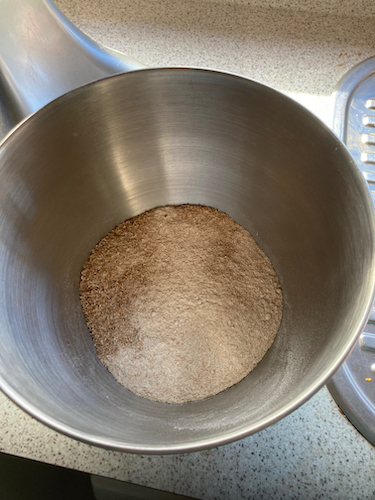
The wheat in this state is a mixture of fine white flour and wheat bran flakes. For a rustic bread it's fine to use as is, or you can sieve the flour to remove the wheat bran if needed. The only step left in this journey is to make bread with the flour, in a future blog post I'll share with you hubby's family famous bread recipe that never fails, using our own homegrown flour!
We are very excited about this, but not only that, hubby has already started mumbling about growing our own maize, so that we can make our own corn chips...
Have a wonderful day
Julie-Ann
Want to discuss my post? Feel free to chat with me on Instagram or Mastodon.




